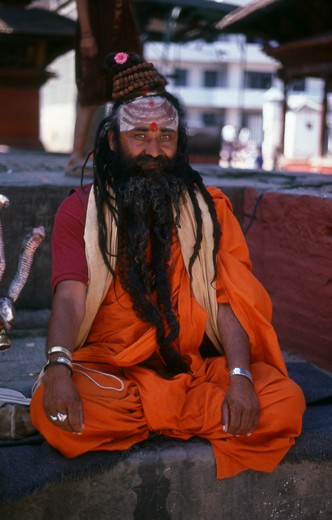Features on Asian Art, Culture, History & Travel
Archives
Archives > NEPAL > Holy Men Of Nepal

Holy Men Of Nepal
Fakirs, Sadhus and Yogis
“And the wildest dreams of Kew are the facts in Kathmandu,” - Rudyard Kipling, 1895
SEE RELATED IMAGES @ PICTURES FROM HISTORY
They are known, variously, as sadhus, yogis, fakirs and sunyasins. They are the ascetic – and often eccentric – practitioners of an austere form of Hinduism. Sworn to cast off earthly desires, some choose to live as anchorites in the wilderness. Others, as these pictures make clear, are of a less retiring disposition, especially in the towns and temples of Nepal's Kathmandu Valley.
The Indian religious traditions are, by and large, mystical in character, and from earliest times asceticism has been highly honoured. The path of the mystic generally starts with ascetic practices as a means of eliminating the desire for worldly existence. The ultimate goal is union with Brahman, the Universal Soul. Thus, in the Vedic commentaries of early Hinduism, the sage Yajnavalkya describes the nature of a redeemed person with these words: "If a man is without desires, free of desires, his vital spirits will not depart. Brahman he is and into Brahman he goes."
In later Hinduism, while ascetics continued to be revered by ordinary people as sadhus (saints, or "good ones") and yogis (ascetic practitioners), the concept of the avatara – the incarnation of a divine being in human form – served to explain the existence of holy men. By means of this concept it was, and still is, possible to consider mystics as incarnations of a deity – usually Vishnu or Saiva.
Even Islam – the most recent of India's great religious traditions, introduced from the Middle East as much by wandering Sufi mystics as by conquering armies between the 8th and 15th centuries – is strongly influenced by mysticism in the subcontinent. The Arabic term faqir, originally meaning poor, but with the additional connotation of an ascetic seeker after the Truth, is widely employed by both Muslims and Hindus throughout the subcontinent. In past centuries, perhaps influenced by the intellectual traditions of the region in which they had settled, Islamic fakirs were known for their practice of chilla, or hanging upside down in a well for 40 days to help achieve enlightenment.
If the Vale of Kathmandu seems to boast more than its share of sadhus and yogis, this is because of the number and importance of Hindu temples in the region. The most important temple of Vishnu in the valley is Changunarayan, and here the visitor will find many Vaishnavite ascetics. Vishnu, also known as Narayan, can be identified by his four arms holding a sanka (sea shell), a chakra (round weapon), a gada (stick-like weapon) and a padma (lotus flower). The best-known incarnation of Vishnu is Krishna, and his animal is the mythical Garuda.
Most of the ascetics featured here, however, are followers of Shiva, whose temple at Pashupatinath is the most important in the valley. Shiva is often represented by the lingam, or phallus, as a symbol of his creative side. His animal is the bull, Nandi, and his weapon is the trisul, or trident. According to Hindu mythology Shiva is supposed to live in the Himalayas and wears a garland of snakes. He is also said to smoke a lot of bhang, or hashish – a practice still clearly followed by many of his devotees today!
SEE MORE HOLY MEN OF NEPAL IMAGES @ PICTURES FROM HISTORY
Text by Andrew Forbes; Photos by Rainer Krack, David Henley & Pictures From History - © CPA Media
